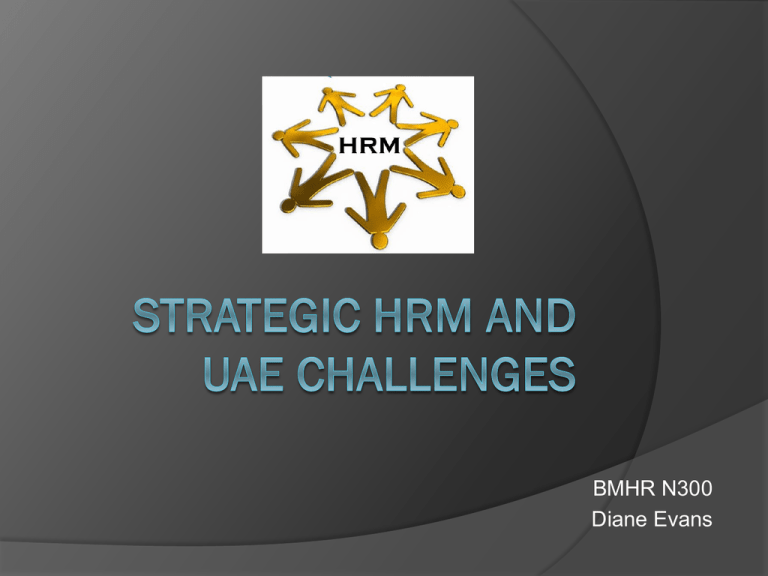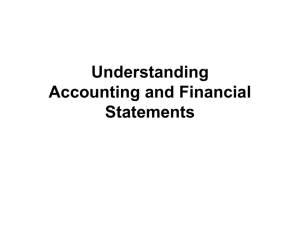
BMHR N300
Diane Evans
Objectives
Define the term ‘strategic hrm’
Identify specific issues of shrm
Apply hr strategies to a case study
HR Management Challenges
Globalization of Business
Outsourcing and increased competition
The threat of terrorism
Economic and Technological Changes
Occupational Shifts
Workforce Availability and Quality Concerns
Technological Shifts and the Internet
© 2007 Thomson/South-Western. All rights reserved.
1–3
Co-operation of HR with Operating Managers
HR Unit
Develops legal, effective
interviewing techniques
Trains managers in
conducting selection
interviews
Conducts interviews and
testing
Sends top three applicants
to managers for final review
Checks references
Does final selection and
hiring for certain job
classifications
Managers
Advise HR of job openings
Decide whether to do own
final interviewing
Receive interview training
from HR unit
Do final interviewing and
hiring where appropriate
Review reference
information
Provide feedback to HR unit
on hiring/rejection decisions
© 2007 Thomson/South-Western. All rights reserved.
1–4
FIGURE 1.2
Changing Roles of HR Management
© 2007 Thomson/South-Western. All rights reserved.
1–5
FIGURE 1.3
Strategic HR Management Process
© 2007 Thomson/South-Western. All rights reserved.
1–6
Nature of strategic HR management
Relationship of Organizational and HR Strategies
Cost Leadership
Differentiation
Competition on the basis
Competition on the basis
of low price and high
quality of product or
service
Relies on “building”
employees to fit
specialized needs
Requires a longer HR
planning horizon approach
of either offering
distinctively different
products or services or
establishing an exclusive
image for quality products
and services
Relies on hiring needed
skills.
Needs a shorter planning
time frame in order to be
responsive to dynamic
environments
© 2007 Thomson/South-Western. All rights reserved.
1–7
Nature of Strategic HR Management
(cont’d)
Customer Service and Quality Products
Linked to HR Strategies
High quality products and services are the
results of HR-enhancements to organizational
performance.
Organizational Culture and Organizational
Effectiveness
Organizational culture—the shared values and
beliefs in an organization
○ Strategy and culture must be compatible and
aligned for the organization to be effective.
○ Culture affects recruitment and retention of
employees.
© 2007 Thomson/South-Western. All rights reserved.
1–8
Human Resource Planning
Human Resource (HR) Planning
The process of analyzing and identifying the
need for and availability of human resources so
that the organization can meet its objectives.
© 2007 Thomson/South-Western. All rights reserved.
1–9
FIGURE 1.4
HR Planning Process
© 2007 Thomson/South-Western. All rights reserved.
1–10
Scanning the External Environment
Environmental Scanning
The process of studying the environment of
the organization to pinpoint opportunities
and threats.
Environmental Changes Impacting HR
Governmental influences
Economic conditions
Geographic and competition issues
Workforce composition
© 2007 Thomson/South-Western. All rights reserved.
1–11
Assessing the Internal Workforce
Jobs and Skills Audit
What jobs exist now?
How many individuals are performing each
job?
What are the reporting relationships of jobs?
How essential is each job?
What jobs will be needed to implement
future organizational strategies?
What are the characteristics of anticipated
jobs?
© 2007 Thomson/South-Western. All rights reserved.
1–12
Assessing the Internal Workforce
(cont’d)
Organizational Capabilities Inventory
HR databases—sources of information
about employees’ knowledge, skills, and
abilities (KSAs)
Uses of KSA inventories
○ Recruiting
○ Selection
○ HR development
○ Capabilities of future workforce
© 2007 Thomson/South-Western. All rights reserved.
1–13
Forecasting HR Supply and Demand
Forecasting
The use of information from the past and
present to identify expected future conditions.
Forecasting Periods
Short-range: six months to one year
Intermediate-range: up to five years
Long-range: more than five years
© 2007 Thomson/South-Western. All rights reserved.
1–14
HR Forecasting
© 2007 Thomson/South-Western. All rights reserved.
1–15
Factors Affecting External HR Supply
Net migration for an area
Individuals entering and leaving the workforce
Individuals graduating from schools and colleges
Changing workforce composition and patterns
Economic forecasts
Technological developments and shifts
Actions of competing employers
Government regulations and pressures
Other circumstances affecting the workforce
© 2007 Thomson/South-Western. All rights reserved.
1–16
Forecasting HR Supply and Demand
(cont’d)
Forecasting Internal HR
Supply
Effects of promotions, lateral
moves, and terminations
Succession Planning
Long-term plan to replace key
employees.
Managing an expatriate
workforce
© 2007 Thomson/South-Western. All rights reserved.
1–17
Measuring HR Effectiveness (cont’d)
Measures of Strategic HR Effectiveness
(cont’d)
Return on Investment (ROI)
○ A calculation showing the value of expenditures for HR
activities and how long it will take for the activities to
pay for themselves.
Economic Value Added (EVA)
○ A firm’s net operating profit after the cost of capital (the
benchmark for minimum return) is deducted.
HR and the Balanced Scorecard
○ Financial
○ Internal business processes
○ Customer
○ Learning and growth
© 2007 Thomson/South-Western. All rights reserved.
1–18
Measuring HR Effectiveness (cont’d)
HR Measurement and Benchmarking
Benchmarking
○ Comparing specific measures of performance
against data on those measures in other
organizations.
HR Audit
A formal research effort that evaluates the
current state of HR management in an
organization.
Audit areas:
○ Staffing
○ Compensation
○ Health and Safety
© 2007 Thomson/South-Western. All rights reserved.
1–19
UAE HR Management Challenges
Global perspective and influence
Reliance on expatriate workers for
skills/knowledge needed
Public v private employment
Cultural development – Arab/Islam v
Western/secular
Apply SHRM to a case study
Al Ain Water







